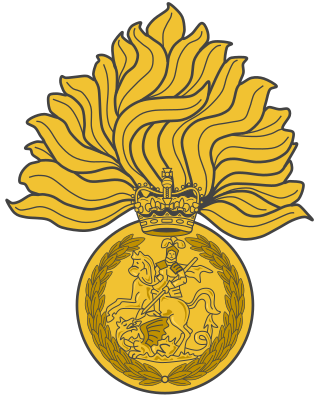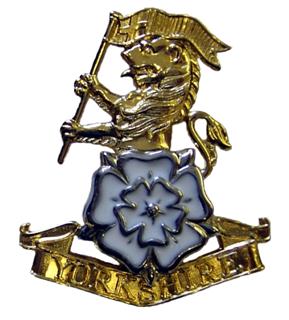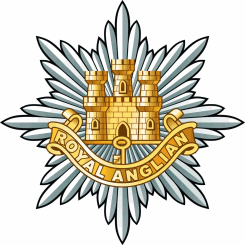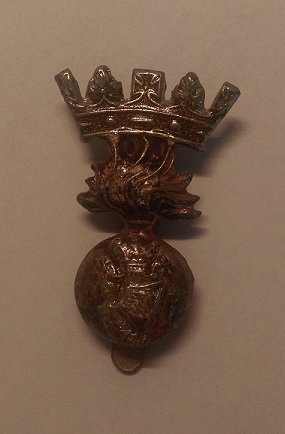
The Royal Regiment of Fusiliers is an infantry regiment of the British Army, part of the Queen's Division. Currently, the regiment has two battalions: the 1st Battalion, part of the Regular Army, is an armoured infantry battalion based in Tidworth, Wiltshire, and the 5th Battalion, part of the Army Reserve, recruits in the traditional fusilier recruiting areas across England. The Royal Regiment of Fusiliers was largely unaffected by the infantry reforms that were announced in December 2004, but under the Army 2020 reduction in the size of the Army, the 2nd Battalion was merged into the first in 2014.
The Ulster Defence Regiment (UDR) was an infantry regiment of the British Army established in 1970, with a comparatively short existence ending in 1992. Raised through public appeal, newspaper and television advertisements, their official role was the "defence of life or property in Northern Ireland against armed attack or sabotage" but unlike troops from Great Britain they were never used for "crowd control or riot duties in cities". At the time the UDR was the largest infantry regiment in the British Army, formed with seven battalions plus another four added within two years.

The Royal Gurkha Rifles (RGR) is a rifle regiment of the British Army, forming part of the Brigade of Gurkhas. Unlike other regiments in the British Army, RGR soldiers are recruited from Nepal, which is neither a dependent territory of the United Kingdom nor a member of the Commonwealth.

The Princess of Wales's Royal Regiment is the senior English line infantry regiment of the British Army, second in the line infantry order of precedence to the Royal Regiment of Scotland and part of the Queen's Division.

The Royal Yorkshire Regiment is an infantry regiment of the British Army, created by the amalgamation of three historic regiments in 2006. It lost one battalion as part of the Army 2020 defence review. The regiment's recruitment area covers the ceremonial counties of the East Riding of Yorkshire, North Yorkshire, South Yorkshire and West Yorkshire; areas near Barnsley are recruitment area for the Rifles.

The Royal Anglian Regiment is an infantry regiment of the British Army. It consists of two Regular battalions and one Reserve battalion. The modern regiment was formed in 1964, making it the oldest of the Line Regiments now operating in the British Army, and can trace its history back to 1685. The regiment was the first of the large infantry regiments and is one of the three regiments of the Queen's Division.
The Royal Irish Rangers was a regular infantry regiment of the British Army with a relatively short existence, formed in 1968 and later merged with the Ulster Defence Regiment in 1992 to form the Royal Irish Regiment.
The Rifles is an infantry regiment of the British Army. Formed in 2007, it consists of four Regular battalions and three Reserve battalions. Each Regular battalion of The Rifles was formerly an individual battalion of one of the two large regiments of the Light Division. Since formation, the regiment has been involved in combat operations in the later stages of the Iraq War and in the War in Afghanistan.

The Royal Irish Rifles was an infantry rifle regiment of the British Army, first created in 1881 by the amalgamation of the 83rd Regiment of Foot and the 86th Regiment of Foot. The regiment saw service in the Second Boer War, the First World War, the Second World War, and the Korean War.
The Royal Scots Borderers, 1st Battalion, the Royal Regiment of Scotland was an infantry battalion of the Royal Regiment of Scotland. The battalion formed on 1 August 2006 when its antecedent regiments - the Royal Scots and the King's Own Scottish Borderers - amalgamated just after the formation of the Royal Regiment of Scotland in 2006. On 1 December 2021, the battalion transferred to the new Ranger Regiment as the 1st Battalion, Ranger Regiment.
The 19th Brigade is an Army Reserve formation of the British Army. As the 19th Infantry Brigade, it fought in the First and Second World War.

HQ Northern Ireland was the formation responsible for the British Army in and around Northern Ireland. It was established in 1922 and disbanded, replaced by a brigade-level Army Reserve formation, 38 (Irish) Brigade, in 2009.

The Royal Irish Fusiliers (Princess Victoria's) was an Irish line infantry regiment of the British Army, formed by the amalgamation of the 87th (Prince of Wales's Irish) Regiment of Foot and the 89th (Princess Victoria's) Regiment of Foot in 1881. The regiment's first title in 1881 was Princess Victoria's (Royal Irish Fusiliers), changed in 1920 to the Royal Irish Fusiliers (Princess Victoria's). Between the time of its formation and Irish independence, it was one of eight Irish regiments.
1st Regiment Royal Horse Artillery is a regiment of the Royal Horse Artillery in the British Army. It currently serves in the armoured field artillery role, and is equipped with the AS90 self-propelled gun. The regiment is currently based at Larkhill Garrison, Larkhill. The regiment completed its move from Assaye Barracks, Tidworth, to Larkhill in June 2019.
This is the Operation Herrick ground order of battle, which lists any British ground forces that have taken part in the duration of Operation Herrick between 2002 and 2014.

1st Battalion, Ulster Defence Regiment was formed in 1970 as part of the 7 original battalions specified in The Ulster Defence Regiment Act 1969, which received Royal Assent on 18 December 1969 and was brought into force on 1 January 1970. It was amalgamated with the 9th Battalion, Ulster Defence Regiment in 1984 to form the 1st/9th Battalion, Ulster Defence Regiment.

2nd Battalion, Ulster Defence Regiment was formed in 1970 as part of the seven original battalions specified in the Ulster Defence Regiment Act 1969, which received royal assent on 18 December 1969 and was brought into force on 1 January 1970. It was, along with the rest of the regiment, amalgamated with the Royal Irish Rangers in 1992 to form the Royal Irish Regiment. It had previously been amalgamated in 1991 with the 11th Battalion Ulster Defence Regiment to form the 2nd/11th Battalion Ulster Defence Regiment.

The 11th (Craigavon) Battalion, Ulster Defence Regiment was formed from companies of the 2nd Battalion Ulster Defence Regiment and the 3rd Battalion Ulster Defence Regiment in 1972. In 1991 under the reductions planned in Options for Change by the British Army, it again amalgamated with 2 UDR to form the 2nd/11th Battalion Ulster Defence Regiment.

The 9th Battalion, Ulster Defence Regiment was formed in 1972 from two companies of the 1st Battalion Ulster Defence Regiment creating a second battalion in County Antrim. It was amalgamated with 1 UDR in 1984 to form 1/9 UDR.

The 1st/9th Battalion, Ulster Defence Regiment was formed in 1984 as a result of an amalgamation between the 1st Battalion Ulster Defence Regiment and the 9th Battalion Ulster Defence Regiment.









